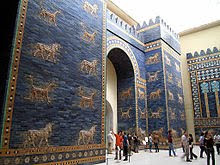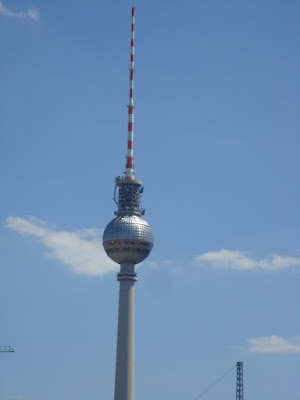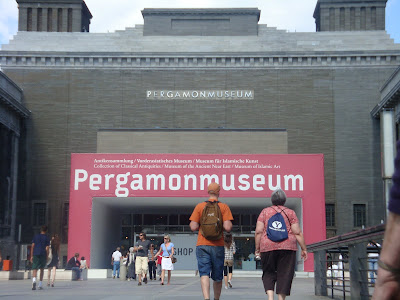AROUND THE CITY
On this day we got on the bus to go to the grocery store, realized it was headed the wrong way and decided to have an adventure. We got off at Alexanderplatz.
 We went in, stood in a long line, bought our tickets, went to the top and enjoyed a beautiful panoramic view of Berlin from the revolving restaurant. We had a delightful lunch.
We went in, stood in a long line, bought our tickets, went to the top and enjoyed a beautiful panoramic view of Berlin from the revolving restaurant. We had a delightful lunch.  As we stood in line we enjoyed another Buddy Bear
As we stood in line we enjoyed another Buddy BearView From the Top
 The west part of Berlin. Notice Tiergarten (park) in the upper left.
The west part of Berlin. Notice Tiergarten (park) in the upper left. A close up of the river. See the two trains passing each other.
A close up of the river. See the two trains passing each other. This close up of Tiergarten shows the Brandenberg Gate and the Victory Column. The Church and our apartment were on the edge of this large garden.
This close up of Tiergarten shows the Brandenberg Gate and the Victory Column. The Church and our apartment were on the edge of this large garden. SIGHTS CLOSE TO OUR HOME
 Kaiser Wilhelm Church (The Old, after the war, and the New)
Kaiser Wilhelm Church (The Old, after the war, and the New)
 There is always some kind of entertainment in this area. This is a drum and brass band from Denmark
There is always some kind of entertainment in this area. This is a drum and brass band from Denmark This man-child was dancing on skateboards to music. He was performing with a group of break dancers.
This man-child was dancing on skateboards to music. He was performing with a group of break dancers.
 Because of all the time we spent watching the World Cup Games we felt it appropriate to take our pictures with this bear.
Because of all the time we spent watching the World Cup Games we felt it appropriate to take our pictures with this bear.TOURING WITH BEN AND HIS MOTHER
Sanssouci Palace in Potsdam
Palace Rooms




On The Way to the Pergamon Museum in Berlin
 This is the actual Zeus Alter (180BC-160 BC) which has been reconstructed and is so large it has a huge room all to itself.
This is the actual Zeus Alter (180BC-160 BC) which has been reconstructed and is so large it has a huge room all to itself. This frieze took over 20 years to reassemble from thousands of fragments uncovered in modern-day Bergama, Turkey. It depicts the struggle of the Olympian gods against the Titans and it is strikingly life-like, with figures that project as much as a foot from the background.
This frieze took over 20 years to reassemble from thousands of fragments uncovered in modern-day Bergama, Turkey. It depicts the struggle of the Olympian gods against the Titans and it is strikingly life-like, with figures that project as much as a foot from the background. The Ishtar Gate (Assyrian: ܕܵܪܘܲܐܙܲܐ ܕܥܵܐܫܬܲܪ translit: Darwaza D'Ishtar, Arabic:بوابة عشتار) was the eighth gate to the inner city of Babylon. It was constructed in about 575 BC by order of King Nebuchadnezzar II. Originally the gate, being part of the Walls of Babylon, was considered one of the Seven Wonders of the world until, in the 6th century AD, it was replaced by the Lighthouse of Alexandria.
The Ishtar Gate (Assyrian: ܕܵܪܘܲܐܙܲܐ ܕܥܵܐܫܬܲܪ translit: Darwaza D'Ishtar, Arabic:بوابة عشتار) was the eighth gate to the inner city of Babylon. It was constructed in about 575 BC by order of King Nebuchadnezzar II. Originally the gate, being part of the Walls of Babylon, was considered one of the Seven Wonders of the world until, in the 6th century AD, it was replaced by the Lighthouse of Alexandria. A reconstruction of the Ishtar Gate and Processional Way was built at the Pergamon Museum in Berlin out of material excavated by Robert Koldewey and finished in the 1930s. It stands 47 feet high and 100 feet wide (14 meters by 30 meters). The excavation ran from 1902-1914 and during that time 45 feet of the foundation of the gate was uncovered. The gate was in fact a double-gate.
The part that is shown in the Pergamon Museum today is only the smaller frontal part, while the larger back part was considered too large to fit into the constraints of the structure of the museum. It is in storage.
 Dedicated to the Babylonian goddess Ishtar, the Gate was constructed of blue glazed tiles with alternating rows of bas-relief sirrush (dragons) and aurochs. The roof and doors of the gate were of cedar, according to the dedication plaque. Through the gate ran the Processional Way which was lined with walls covered in lions on glazed bricks (about 120 of them).
Dedicated to the Babylonian goddess Ishtar, the Gate was constructed of blue glazed tiles with alternating rows of bas-relief sirrush (dragons) and aurochs. The roof and doors of the gate were of cedar, according to the dedication plaque. Through the gate ran the Processional Way which was lined with walls covered in lions on glazed bricks (about 120 of them). 































1 comment:
Dear Schwester Sisters,
I am enjoying my free tour of Berlin! Thank you. I am intrigued by your observation that the east side lacks color. I recently came across some pictures of some old East German factories, by a couple of French photographers.
http://www.marchandmeffre.com/index.html
Click on Eastern Industries.
They also have a series there in which they show what capitalism has done to Detroit, if you are interested.
I think we, as Americans, perhaps, were brought up to look at things in black and white. It's interesting to see another point of view. Anyway, I thought you might appreciate the photographs, being as how you are photographers, too.
Sincerely,
Frank Conway
PS: I really enjoy your blog!
Post a Comment